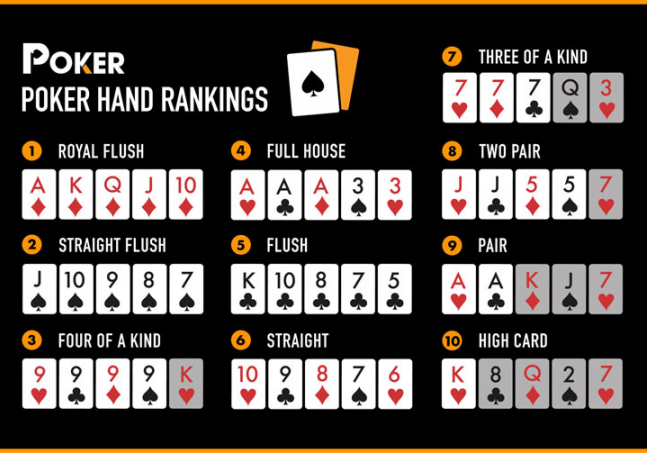Poker requires players to analyze their opponents, bet wisely, and make informed decisions.
One of the key factors of the game is the ranking of poker hands. Understanding how these hands compare to one another is essential for success at the poker table.
This article will explore deeper into the world of poker hand rankings, exploring some in-depth strategies that can help you gain an edge over your opponents.
Understanding Poker Hand Rankings
Before we dive into the more advanced strategies, let's first review the basic poker hand rankings. In poker, hands are ranked in the following order, from highest to lowest:
- Royal Flush: A, K, Q, J, 10, all of the same suit (Considered the best hands in poker)
- Straight Flush: Any five cards of the same suit in sequence
- Four of a Kind: Four cards of the same rank, with one other card as a kicker
- Full House: Three cards of the same rank, with two cards of another rank
- Flush: Any five cards of the same suit, not in sequence
- Straight: Any five cards in sequence, not of the same suit
- Three of a Kind: Three cards of the same rank, with two other cards as kickers
- Two Pair: Two cards of one rank, two cards of another rank, with one other card as a kicker
- Pair: Two cards of the same rank, with three other cards as kickers
- High Card: Any hand that does not fit into the above categories
Now that we have reviewed the basic rankings let's explore some more advanced strategies for comparing poker hands.
Consider the Board
One of the most important things to consider when comparing poker hands is the board. The board refers to the community cards that are available to all players. These cards can greatly impact the strength of each player's hand.
For example, let's say the board is showing a flush draw. This means that there are four cards of the same suit on the board, and one player has two more cards of that suit in their hand.
In this scenario, the player with the two suited cards is in a much stronger position than the player without any suited cards. The same principle applies to other board textures, such as paired boards or straight draws.
Pay Attention to Your Opponents
Another important aspect of comparing poker hands, when you play free online poker, is paying attention to your opponents. Understanding their tendencies, betting patterns, and tells can help you make more informed decisions about the strength of their hands.
For example, if an opponent who typically plays tight suddenly makes a large bet, it is likely that they have a very strong hand. Conversely, if an opponent who typically plays loose suddenly checks, they may be trying to lure you into a trap.
Bluffing can also impact the strength of an opponent's hand. If an opponent makes a large bet on a bluff, they may be trying to scare you off a weaker hand. Conversely, if an opponent makes a small bet on a strong hand, they may be trying to lure you into calling.
Use Position to Your Advantage
Position is another key factor in comparing poker hands. Players who are in late position have a significant advantage over players in early position, as they have more information about their opponents' actions.
For example, let's say you are in late position, and your opponent makes a large bet. By the time the action gets to you, you have seen how other players have acted, and you have a better understanding of your opponent's hand strength. This puts you in a much stronger position than if you were in an early position and had to act first.
Understand Pot Odds and Expected Value
Pot odds and expected value are two concepts that are essential for successful poker players to understand. Pot odds refer to the ratio of the current size of the pot to the size of the bet you need to call.
Expected value refers to the amount of money you can expect to win or lose on average from a particular action, like when you play free online slots.
To make informed decisions when comparing poker hands, it is important to understand how pot odds and expected value impact your decisions.
For example, if the pot odds are favorable and the expected value is positive, it may be a good decision to call a bet, even if your hand is not particularly strong.
On the other hand, if the pot odds are unfavorable and the expected value is negative, it may be a good decision to fold, even if you have a relatively strong hand.
By understanding these concepts, you can make more informed decisions about when to call, raise, or fold.
Consider Your Hand Range
Hand range is another important concept to consider when comparing poker hands. Hand range refers to the range of hands that a player is likely to have based on their actions and betting patterns.
By considering your own hand range and the range of your opponents, you can make more informed decisions about the strength of your hand.
For example, if you have a strong hand and your opponent's betting pattern suggests that they have a weak hand, it may be a good decision to make a large bet to try to push them off their hand.
Similarly, if your opponent's hand range is likely to include a strong hand, it may be a good decision to fold, even if you have a relatively strong hand yourself.
By considering hand ranges, you can make more informed decisions about the strength of your opponent's hands and the likelihood that your own hand is the best.
Conclusion
In conclusion, comparing poker hand rankings is a complex and nuanced process that requires skill, strategy, and a deep understanding of the game.
By considering factors such as the board, your opponents, position, pot odds, expected value, and hand range, you can gain an edge over your opponents and make more informed decisions about when to call, raise, or fold.
Ultimately, the key to success in poker is to remain flexible and adaptable, constantly adjusting your strategy to the changing dynamics of the game.
By mastering the strategies outlined in this article, you can take your poker game to the next level and compete at the highest levels of the game.










.jpg)




 pays out over $37 million to Ontario municipalities in 2nd quarter.jpg)


How does it work?
Locate and discover worldwide casinos
Find their promotions, events and enjoy exclusive deals
Good luck!